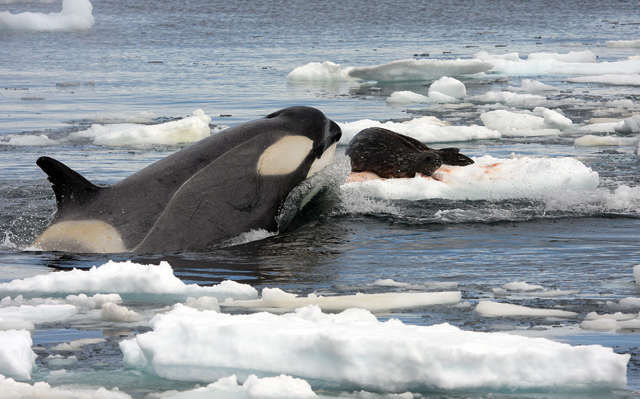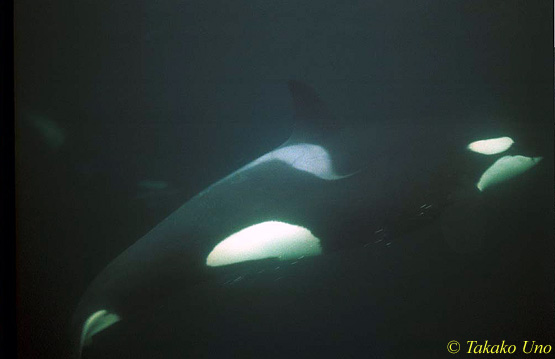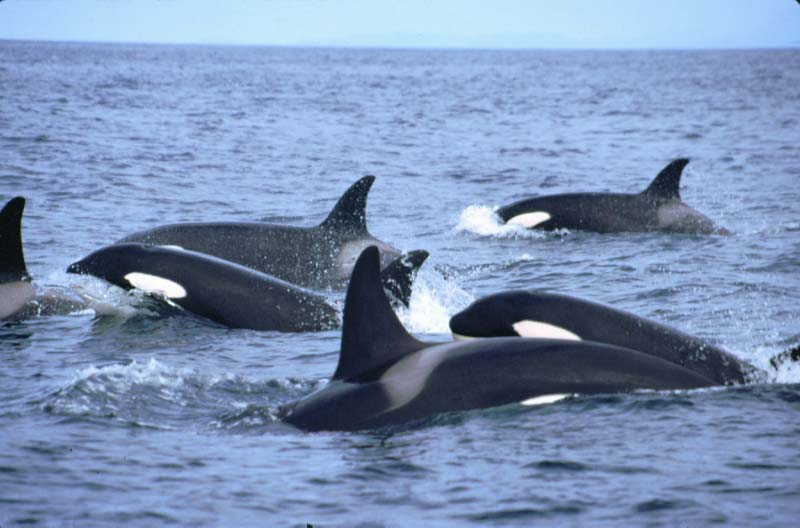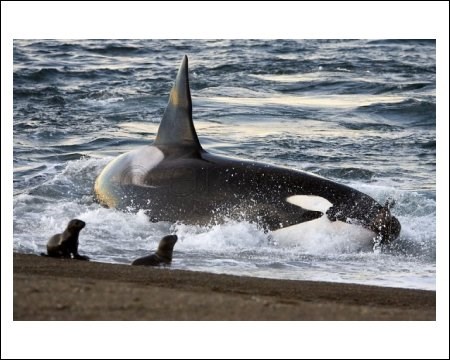The answer is C. Killer Whale! 

J1 "Ruffles" and his mother J2 "Granny" (Psst: Granny is 101 years old!)
Basic Killer Whale Facts
Range: Worldwide
Diet: Fish, Birds, Seals, Sharks, Rays, Other whales, dolphins and porpoises. (There is a record of Transient Killer Whales taking and eating Moose and Caribou as they migrate. Along with reptiles and polar bears in some parts of the world.)
Size: Males: on average 26- 29 feet long and weigh in at 8,000 to 12,000 pounds, the largest was Keiko at 35 feet long and 12,000 pounds.
Females are about 20-26 feet long and weigh at 3,000 to 6,500 pounds.
Lifespan: Females: 50 to 90 years Males: 25 to 40 years
Residents V.S. Transient V.S Offshore
Residents:
Diet consists of fish, and only fish.
All young stay with mother for life.
Have strict migration routes they follow year round.
Pod Size ranges from 10 to 20 animals.
Transients:
Diet consists of anything but fish.
Males at 16 years and older may leave. Once daughters have young of own will leave mother.
Sporadic migrations. One pod was in southern Alaska, in ten days was spotted in Puget Sound.
Pod size of 1 to 6 animals.
Offshore:
Not much known due to migration routes and how rarely they come close to shore.
Family size is 20 to 60 animals, sometimes more, record of 200 in one location in Washington state.
In size they are smaller than Resident and Transient killer whales
Diet? Possibly oceanic fish and shark, their vocal activity shows that they are not mammal eating whales.

Resident Killer Whale pod, This is L pod in California waters.

Transient Killer Whale pod, this is actually a "reserve" Pod called in by the matriarch during a hunting training session for juveniles and calves.

Offshore Killer Whale pod, again off the coast of California.
Notice the difference with the fins?

Another way to tell is to watch for how they come up to breath and when they dive, mammal eaters rise and dive in perfect synchrony during a hunt but will act more like resident and offshore killer whales after a successful hunt. Residents and Offshores are highly social and do nit rise and dive in perfect synchrony, maybe a pair will or a small group of three to four might. At the surface you can hear Residents and Offshores calling to one another. Transients seldom or very rarely vocally communicate.
Antarctic Killer WhalesThere are 5 species of killer whales in the Antarctic region of the globe.
The largest is type A with males being able to reach 32 feet in length, while the Ross Sea or Type C killer whale is not only the smallest in the region but in the world with the largest males reaching 18 feet in length.
Diet: Type A: Whales Type B (large): Seals Type B(small): Penguins
Type C: Fish among the ice Type D: Oceanic fish

Type A, they specialize in hunting whales; mostly Antarctic Minke Whales. They live in fairly small groups from 10 to 15 animals, a similar species is seen up in the Arctic waters and hunt the same kind of whales as their southern cousins.

Type B (Small), these guys primarily hunt penguins that live in the ice, they live in small pods, and it is seen that the males may break away to hunt on their own. But like with the females the males of a pod work together for a kill. They may every now and then eat a seal.

Type B (Large), these guys primarily hunt for seals in the open waters and loose pack ice, but they may take a penguin here and there. They live in pods similar in size with their smaller cousins.
A note about the type B: They are subspecies of each other, the larger hunting more in the open waters with little ice hunting for seals, the smaller hunts in the ice for penguins. Unlike type A, type B Orcas are related to the oldest female somehow and stay for their whole lives, they may trade males for breeding purposes, but go back to their original pods at the end of the breeding season.

Type C (From studying photos there appears to be variations of this species, so maybe subspecies of these guys.), they only hunt for fish in the pack ice, mostly Antarctic Cod that they seem to specialize in hunting. They are the smallest not only in the region but possibly in the world. They are very vocal, and playful animals with strong family bonds where the offspring stay with their mothers for their whole lives like Resident Killer Whales in the United States.

Type D, have a more bulbous head and small eye patch. They are very vocal which tells researchers that they are fish eaters, as well as possibly killers of sharks. There is a second subspecies of this group that inhabits the waters of New Zealand and only migrate around those islands. Although they are saying that there is a third subspecies that hunts for penguins, seals, whales and dolphins.
But Wait, there are others! Well basically for each region of the world there are different types of killer whales, each with their own dialects, diets, and cultures.�
What do I mean by culture? For example northern killer whales (North Alaska to northern Washington) beach rub, but southern killer whales never beach rub and instead do explosive displays of breaching, lob tailing and other surface displays.
Each Killer Whale group follow a basic design but vary from group to group. Maybe the following photos and facts will show you.
Areas: UK, Norway, Japan, Iceland, South America
Norway and UKNorway:
Migrate between Scotland and Norway
Feed on only fish like Herring.

Killer Whale hunting Herring.
UK:
3 species*
One feeds on seals and dolphins, the other feeds on fish and sharks
Inhabit the east coast of UK, and the channels between France, and Ireland.

Pod that feeds on Dolphins and seals. The whale at the far right is John Coe.

The Third species of Orca, they feed primarily on fish and shark.
*There has been two more 'species' of Orca's found in the UK waters. The fourth has an unpredictable pattern so it is not known if they represent something like the Offshore killer whale as seen in America or if they travel to the UK from elsewhere.

A member of a killer whale pod that specializes in hunting large whales, and dolphins. This species is newly discovered and is believed to inhabit the waters around Shetland Island.
Other Whales: Iceland and South America

One of two orca species off the coast of Iceland. Hunting for other whales.

Killer Whale in South America named "Big Mel" beaches himself to catch a seal.
Russia
These are killer whales off the coast of Russia, the white Orca in the middle is named "Iceberg" He is the only known white killer whale in the world. This pod are fish eaters.
I know that I said I was going to do a section on killer whales in Japan but all the pictures I am finding is the whales being brutally killed and are very graphic so I will not be posting them for that and because the photos make me cry.
So I am going to post these instead.
www.youtube.com/watch?v=0URtbLWBZdAwww.youtube.com/watch?v=RnNv2VsKPgc&feature=relmfu www.youtube.com/watch?v=yxEWXchUTrI&feature=relmfuwww.youtube.com/watch?v=p3xmqbNsRSkwww.youtube.com/watch?v=96yynCGST8U&feature=relmfuAny questions?
























